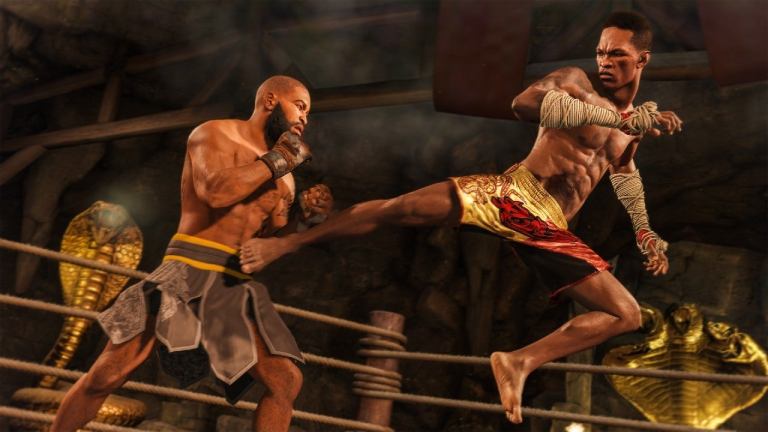How UFC 4 Is Changing the Way We Play MMA Games
We talked to the team at EA Sports about UFC 4 and its changes to the submission system, takedowns, striking, and more!

For the UFC, there is no season. Fights happen year round for the world’s premier mixed martial arts promotion. So, unlike annualized franchises such as Madden, EA Sports’ UFC franchise isn’t beholden to the same yearly release structure.
But even for the UFC series, the two-and-a-half-year gap between UFC 3 and the upcoming UFC 4, slated for an Aug. 14 release on PlayStation 4 and Xbox One, is a long time. Even the transition between the former THQ-published UFC Undisputed franchise and the first EA Sports UFC in 2014 wasn’t quite as long.
Rest assured, creative director Brian Hayes and his team have used the time to make major changes to some of the more maligned gameplay systems from previous iterations of the series. Every element of the octagon action has been either tweaked or overhauled.
Perhaps no system has been as obtuse for the greatest number of UFC players over the years than the ground game. Grappling and submissions are integral to the sport of MMA, so real fighters who can’t tell a kimura from an omoplata probably won’t make it far in the sport. UFC 4 won’t be issuing quizzes on the difference between Brazilian jiu-jitsu shoulder locks, but it has made dramatic changes to the way fights on the floor are contested. Two new submission mini-games replace the former system, which utilized a battle over “break walls” using the left and right analog sticks.
“They’re different in a very subtle way,” Hayes tells Den of Geek, referring to the two new submission mini-games. “The basic premise is the same. If you’re in a submission game, and you’re on defense, you have a colored wedge, and your opponent has a colored wedge. Their goal is to keep their wedge on top of yours. In the choke submission game, it’s played on a full circle. In the joint submission game, it’s played on an arc. The control for the choke is with a stick, and the controls for the arc are with triggers.”
You can see how the new submission system, and some of the other gameplay improvements, work in the video below:
Conventional wisdom might suggest players on defense rapidly move their wedge around to escape the hold. Not so, says Hayes. Instead, he says precision control of the defending player’s wedge is critical to staying out of trouble and keeping the wedge from getting too big. He compares the idea to real-life grappling situations, where keeping a cool head and mounting a technical defense often makes the difference between a successful submission defense or a brual tap-or-snap situation.
“The reason that sort of nuance comes in there is we thought of that in terms of, if you’re training in an actual gym and you get into a dangerous situation like a submission, pretty sure that your coach never tells you, ‘OK, freak out now. Just panic. Just flail away as quickly as you can,'” Hayes says. “They’re gonna tell you, no, be calm, focus on your technique, do the right things to get out of this position.”
A few new wrinkles were added to the submission battles in UFC 4 beyond the mini-games themselves. Attackers can now mix in strikes to soften up their opponent, while those on defense might be able to execute slams to get out of certain holds in less technical, more strength-based ways. Outside of the sub attempts, navigating transitions on the mat has been simplified as well with more basic left-stick inputs to execute actions such as standing up, advancing positions, or posturing up for heavy ground-and-pound.
Of course, every UFC fight begins in an upright position, and some will never hit the canvas unless a fighter is put there by a heavy strike or two. For UFC 3, the striking system was overhauled using the same Real Player Motion Tech featured in EA Sports’ FIFA and NHL franchises, among others, in an effort to create a more locomotion-driven striking system. That RPM Tech has now been applied to a completely new system for the clinch game and takedowns.
Gone is the old system of clinch transitions, which worked the same as the grappling dynamic of holding the right stick in a direction to change positions with a HUD as a guide. Now, players enter the clinch with a simple strike input and a modifier, and transitions are executed the same way. Striking controls will work the same way in the clinch as they do from distance, with uppercuts, knees, and more available to throw. Staying in the clinch is as simple as moving toward your opponent, while exiting means moving away.
“Maintaining the clinch or getting out of the clinch is simpler than it’s ever been because it’s actually an intuitive, ‘Well, I don’t want to be here, so I’ll just walk away,’” Hayes says. “It doesn’t get much simpler than that.”
If the changes to the clinch, takedown, and submission systems are best described as a revolution, then consider the differences between striking in UFC 3 and UFC 4 as more evolutionary. Rather than rewriting the script of punches, kicks, knees, and elbows from scratch, EA Sports just wants to make the execution of many of these strikes less clunky than before. In UFC 4, tapping one of the primary strike buttons executes a different strike than holding that same button — the hold mechanic being new to the series. Hayes says this was done to reduce the execution of certain advanced strikes from five or six simultaneous inputs to three or four.
“That was because the multitude of different strikes fighters in the UFC can throw requires such a great deal of real estate on a controller that only has so many inputs,” Hayes says. He notes that the bulk of the striking should feel similar to those already comfortable with and skilled in the striking from UFC 3. The adjustment will come in how attacks such as spinning strikes or roundhouse kicks are performed.
A byproduct of this shift away from so many concurrent inputs is improved responsiveness. Hayes says that every strike in the game is now one to two frames more responsive than in the past.
“We managed to eliminate some input latency where, previously, we had to wait to be sure we knew what you were doing, and now we don’t,” Hayes says. “There should be an increase in responsiveness with every single strike that you can throw in the game. …. It should get to your opponent’s face a little bit faster than it did previously.”
As much as the gameplay has changed, its console home won’t be any different. EA currently has no current plans to release UFC 4 for the upcoming PlayStation 5 or Xbox Series X. No talk of a PC or Switch version, either.
“We’ve been building this product for the last two years,” says producer Nate McDonald, who, like Hayes, has been a part of the UFC series since it began. “The focus has been heavily on the Gen 4, PS4, Xbox One title because we want to make the best experience we possibly can with this particular product. We are exploring opportunities on Gen 5 and what that could potentially mean, but we don’t have any specifics to share at this point in time.”
We’ll keep you updated as we learn more about UFC 4 closer to launch.


